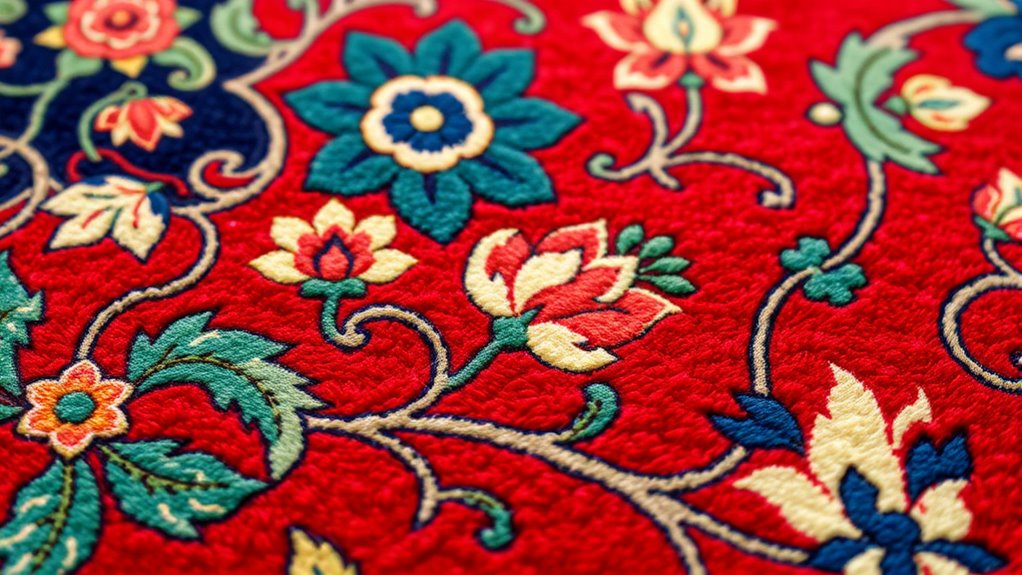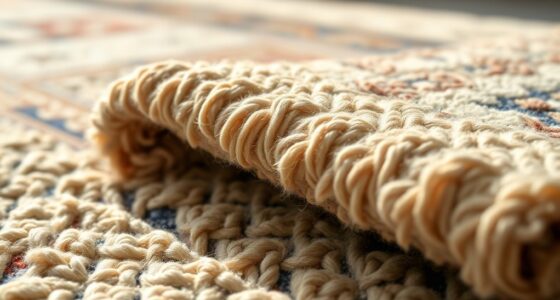Interpreting floral motifs in Persian carpets helps you understand their deep symbolism, regional styles, and cultural significance. Flowers like roses, lotuses, and tulips often represent love, purity, fertility, or spiritual growth, with colors adding extra meaning. Different regions craft unique designs, reflecting local traditions and history. Skilled artisans use specific techniques to depict flowers with realism and artistry. By exploring these details, you’ll uncover personal stories, authenticity clues, and the rich heritage behind each carpet—so continue exploring for more insights.
Key Takeaways
- Floral motifs symbolize spiritual concepts like purity, love, and renewal, with specific flowers carrying distinct symbolic meanings.
- Regional variations in floral designs reflect local artistic traditions, botanical influences, and historical trade interactions.
- Artistic techniques such as detailed brushwork and natural dyes enhance the realism and symbolic depth of floral patterns.
- Botanical accuracy and color symbolism help date carpets and identify their cultural and historical origins.
- Recognizing regional styles and craftsmanship details aids in authenticating and understanding the symbolic significance of floral motifs.
The Significance of Floral Patterns in Persian Culture
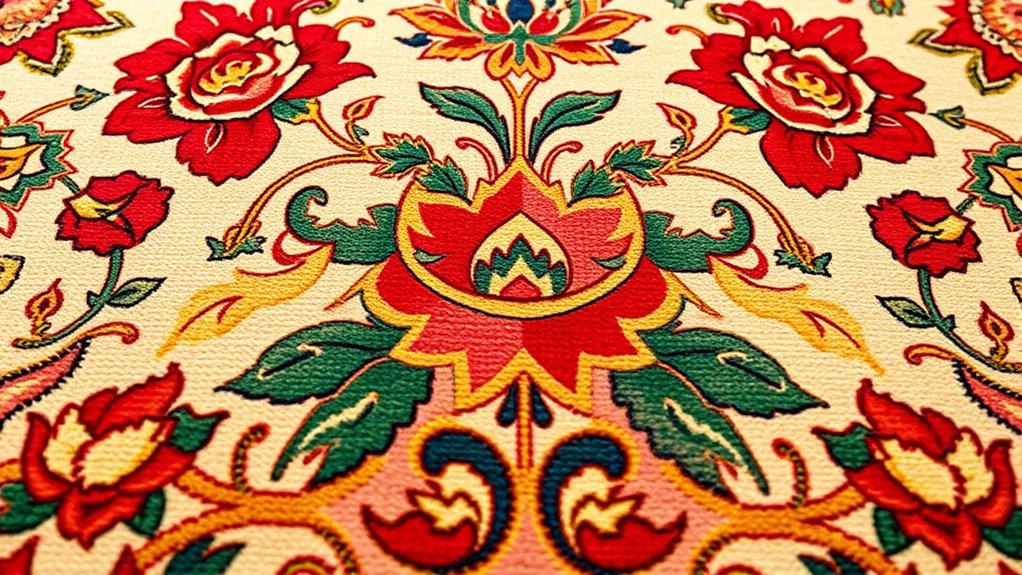
Floral patterns hold a deep and lasting significance in Persian culture, symbolizing beauty, spirituality, and the cycle of life. When you examine these motifs, you notice the attention to botanical anatomy, where each flower’s shape and structure reflect specific meanings. For example, a lotus may symbolize purity, while a rose often represents love. The colors used in these patterns are not random; they carry floral color symbolism that enhances their significance. Bright reds can signify passion, while greens symbolize renewal and growth. You see how artisans carefully select these elements to convey messages beyond mere decoration. Understanding this connection between botanical anatomy and floral color symbolism allows you to appreciate the depth and spiritual resonance embedded within Persian floral motifs. Additionally, the design techniques employed in creating these patterns often involve intricate symbolism that further enriches their cultural importance.
Common Floral Symbols and Their Meanings
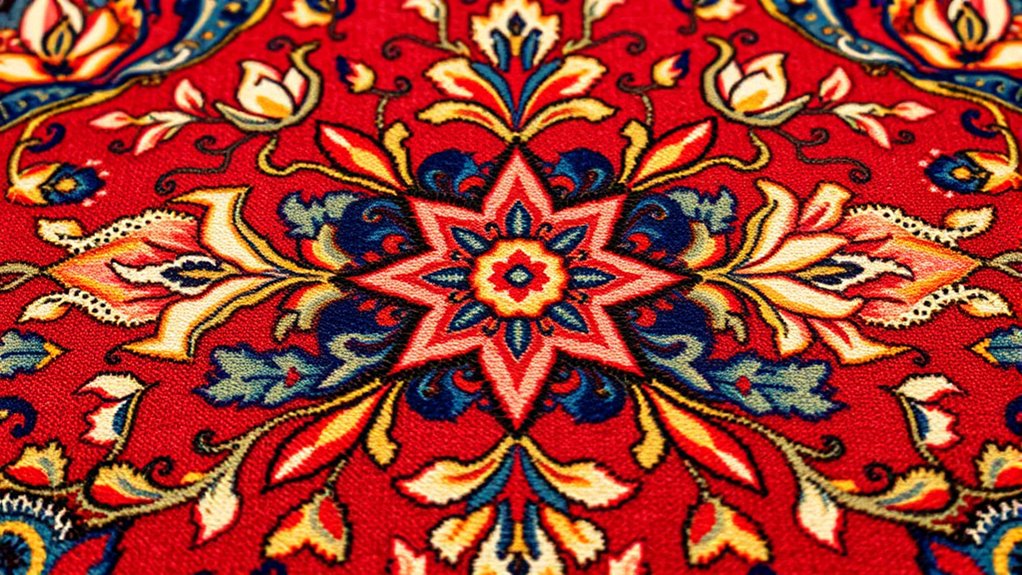
Many floral symbols carry specific meanings that communicate deeper messages in art and culture. In Persian carpets, each motif reflects a botanical taxonomy, symbolizing virtues, beliefs, or wishes. For example, a lotus often signifies purity, while a pomegranate can symbolize fertility. These symbols are carefully chosen in the floral arrangement, conveying layered messages. Visualize these symbols with this table:
| Floral Symbol | Meaning |
|---|---|
| Rose | Love, beauty |
| Cypress | Eternal life, resilience |
| Tulip | Prosperity, abundance |
| Lotus | Spiritual purity |
| Pomegranate | Fertility, renewal |
Understanding these meanings helps you interpret the cultural significance behind each motif, revealing the intricate storytelling woven into Persian art. Additionally, recognizing the cultural symbolism of each flower enhances appreciation of the craftsmanship and historical context.
The Role of Nature and Spirituality in Motif Selection
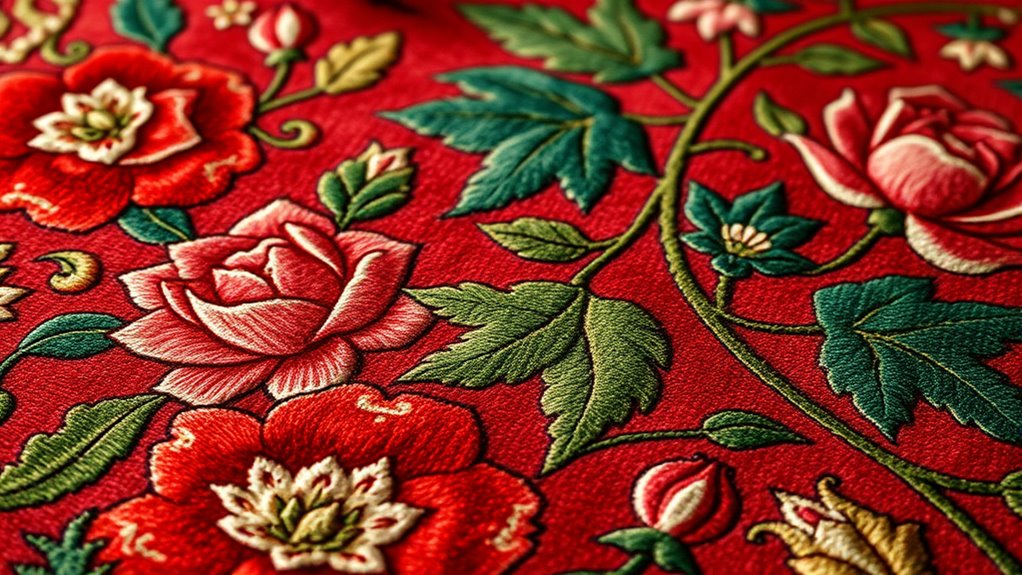
Nature and spirituality are deeply intertwined in the selection of motifs, guiding artists to embed symbolic meanings that resonate beyond mere decoration. You’ll notice that botanical symbolism often reflects spiritual significance, representing concepts like renewal, paradise, or divine harmony. Artists choose specific flowers and plants to convey deeper messages, connecting earthly beauty with spiritual ideals. This thoughtful selection elevates the carpet from simple ornamentation to a meaningful expression of faith and cultural values. Design elements such as color and pattern further reinforce these symbolic themes, creating a harmonious blend of aesthetics and spirituality.
Regional Variations in Floral Designs

Have you ever noticed how floral motifs vary distinctly across different regions? In some areas, designs draw inspiration from medieval gardens, featuring intricate, layered blossoms that symbolize paradise. Other regions emphasize bold, stylized flowers seen in regional embroidery, often simplified yet deeply symbolic. These variations reflect local cultural influences, climate, and historical trade routes. For example, southern Persian carpets might showcase more elongated, flowing floral patterns, while northern regions favor compact, geometric arrangements. The regional differences also reveal unique aesthetic preferences and technical skills passed down through generations. Recognizing these distinctions helps you appreciate the rich diversity in Persian floral motifs, understanding that each design tells a story rooted in a specific cultural and historical context. Additionally, the drainage systems used in different regions can influence the types of plants and motifs cultivated or depicted in the carpets.
The Symbolism of Specific Flowers in Persian Carpets

You’ll notice that certain flowers in Persian carpets carry specific meanings. For example, a rose often symbolizes love and beauty, while a lotus represents purity and enlightenment. The narcissus can remind you of self-examination or vanity, adding deeper layers to the design. Additionally, understanding the symbolic significance of these motifs can enhance your appreciation of the craftsmanship and cultural context behind each piece.
Rose: Love and Beauty
Why do Persian carpets often feature roses, and what do they symbolize? Roses, with their rich botanical classification, are key symbols of love and beauty in Persian floral symbolism. They represent the divine and the earthly, blending spiritual and worldly affection. You’ll notice that roses evoke passion, elegance, and harmony in the intricate designs. Their detailed depiction highlights their importance in Persian culture, reflecting ideals of romance and aesthetic perfection. The floral symbolism of roses emphasizes both physical and spiritual love, making them a central motif in carpet art. By incorporating roses, artisans communicate deeper emotional and cultural values, elevating simple decorative motifs to symbols of profound meaning and timeless beauty. Additionally, understanding the symbolic significance of flowers like roses enhances appreciation of the intricate craftsmanship behind Persian carpets.
Lotus: Purity and Enlightenment
What makes the lotus a powerful symbol in Persian carpets is its deep association with purity and spiritual awakening. Its meditative symbolism encourages reflection and inner peace, making it a meaningful motif for spiritual growth. The lotus’s ability to emerge pristine from muddy waters signifies spiritual purity, reminding you of the potential for enlightenment amid life’s challenges. When you see this flower woven into a carpet, it’s not just decorative—it’s an invitation to pursue spiritual clarity and transcendence. The lotus’s elegant form and symbolism serve as a reminder that true enlightenment requires purity of mind and heart. By incorporating this motif, Persian artisans connect you to timeless themes of renewal, purity, and spiritual awakening. Additionally, the lotus’s significance is often linked to symbolic representation of enlightenment and rebirth in Persian art.
Narcissus: Self-Aexamination and Vanity
The narcissus flower in Persian carpets often symbolizes self-examination and vanity, inviting you to reflect on your inner qualities and surface appearances. Its flower symbolism emphasizes the importance of understanding oneself beyond external beauty. The floral color meanings further enrich this message; for example, white narcissus suggests purity and humility, while yellow hints at superficial charm. You might notice how the flower’s delicate shape encourages introspection, urging you to look inward. The motif serves as a reminder to balance self-love with humility, avoiding vanity. In carpet design, the placement of the narcissus highlights the contrast between inner virtue and outward appearance. Recognizing these symbols deepens your appreciation of Persian artistry and the layered meanings behind floral motifs. Additionally, understanding the symbolic significance of such motifs enhances your overall grasp of traditional Persian craftsmanship.
Colors and Their Interpretative Value in Floral Motifs

Have you ever noticed how different flower colors evoke specific feelings or symbolize particular ideas? In Persian carpets, color plays a crucial role in botanical symbolism and color psychology. For example, red often signifies passion or love, while white represents purity and spirituality. Blue can evoke serenity and protection, and green symbolizes growth and renewal. Imagine this imagery: Color symbolism is deeply embedded in the cultural and artistic traditions of Persian craft.
The Artistic Techniques Used to Depict Flowers

Artists employ a variety of techniques to bring floral motifs to life, transforming simple botanical forms into enthralling works of art. You’ll notice skilled craftsmanship in how flowers are depicted, often through detailed botanical illustration that emphasizes accuracy and beauty. Dyeing techniques also play a crucial role, using vibrant colors to enhance floral details and create depth. To achieve this, artisans:
- Use fine brushwork for intricate petal and leaf details
- Incorporate watercolor effects for subtle shading
- Apply traditional dyeing methods to produce rich, lasting hues
- Employ layering techniques to add dimension and realism
- Understanding regional divorce statistics can offer insight into cultural influences on artistic expression
These methods allow artisans to capture the delicate elegance of flowers, making each motif both visually striking and symbolically meaningful.
Personal and Familial Stories Embedded in Floral Designs

Many floral designs carry personal and family stories that go beyond aesthetics. You might notice symbols of family heritage or motifs that represent cherished memories. These floral elements often tell heartfelt love stories passed down through generations.
Family Heritage Symbols
Family heritage symbols often find their way into floral motifs, serving as visual stories that connect you to your roots. These symbols incorporate botanical symbolism to represent ancestral values, stories, or lineage. By understanding floral arrangement techniques, you can recognize how certain flower combinations convey specific family histories. For example, a particular flower might symbolize a family’s origin or a cherished tradition. These motifs aren’t just decorative—they encode personal and familial narratives. Recognizing these symbols helps you appreciate the deeper meaning behind the design.
- Use of specific flowers to denote family lineage
- Colors representing ancestral heritage
- Repeated motifs symbolizing continuity
- Arrangement styles reflecting cultural traditions
Personal Memory Motifs
Floral motifs often serve as more than decorative elements; they act as visual narratives that capture personal and familial memories. You might notice garden symbolism in these designs, representing cherished places or spiritual growth. Some motifs reflect botanical realism, depicting specific flowers linked to personal stories or family traditions. For example, a rose may symbolize love passed down through generations, while a jasmine flower could evoke childhood memories or special gatherings. These motifs allow you to connect with the weaver’s personal history, turning the carpet into a tapestry of meaningful moments. By observing the choice and arrangement of flowers, you gain insight into individual stories embedded within the broader cultural symbolism, making each carpet a unique reflection of personal memory.
Ancestral Love Stories
Have you ever wondered how floral designs carry stories of love passed down through generations? In Persian carpets, these motifs often reflect ancestral love stories, embedded within intricate patterns. By examining botanical taxonomy, you can uncover symbolic meanings behind specific flowers, revealing familial bonds and romantic tales. These floral elements serve as visual storytelling devices, connecting past and present. Today, modern floral trends influence carpet designs, blending traditional motifs with contemporary aesthetics. Recognizing these patterns helps you understand personal and familial histories woven into each piece.
- Symbolic meanings of flowers in familial contexts
- How botanical taxonomy reveals love stories
- Evolution of floral motifs through modern trends
- Personal stories reflected in floral arrangements
How to Authenticate and Date Carpets Through Floral Elements

Authenticating and dating carpets based on their floral motifs requires careful analysis of the design elements, color palette, and craftsmanship. Focus on botanical accuracy, ensuring the floral forms reflect authentic plant shapes and growth patterns. Dye analysis also plays a crucial role; older carpets often feature natural dyes, which fade and alter over time. Examine the following table to identify key floral features linked to specific periods:
| Feature | Description | Approximate Date |
|---|---|---|
| Symmetrical Flowers | Precise, balanced design | 16th-17th century |
| Vibrant Colors | Use of natural dyes, bright hues | 14th-15th century |
| Fine Detailing | Intricate, delicate embroidery | 18th century |
This approach helps verify authenticity and approximate age through botanical accuracy and dye analysis.
Tips for Appreciating and Analyzing Floral Motifs in Collecting

When appreciating and analyzing floral motifs in carpets, paying close attention to their design details can reveal much about their origin and craftsmanship. Focus on botanical accuracy to distinguish regional styles and recognize unique plant representations. Observe the floral color symbolism, as different colors often convey specific meanings or cultural messages. Consider the symmetry and repetition of motifs, which reflect the carpet’s overall harmony and design intent. Additionally, examine the intricacy of the floral patterns, as detailed craftsmanship indicates skilled artisanship. To deepen your understanding, look for these aspects:
- Botanical accuracy and authenticity of plant depiction
- Floral color symbolism and cultural significance
- Symmetry and repetition in the motif layout
- Level of detail and craftsmanship in floral design
Frequently Asked Questions
How Do Floral Motifs Influence the Value of Persian Carpets?
Floral motifs considerably influence the value of Persian carpets by showcasing their cultural significance and artistic complexity. When you see intricate, well-preserved floral designs, it indicates skilled craftsmanship and cultural richness, boosting the carpet’s worth. These motifs reflect historical traditions and artistic mastery, making the piece more desirable. Your appreciation of these details enhances your understanding of its value, as floral motifs are a key element that elevates Persian carpets’ prestige and price.
Are There Specific Flowers Linked to Persian Mythological Stories?
You might wonder if specific flowers in Persian carpets have mythological symbolism. Yes, certain floral allegories represent mythological stories—like the lotus symbolizing purity and spiritual awakening. These motifs connect to Persian cultural beliefs and mythic traditions. Recognizing these flowers helps you appreciate the deeper layers of meaning woven into the carpet’s design, enriching your understanding of its artistic and cultural significance.
How Do Floral Designs Vary Between Urban and Rural Carpet Traditions?
Imagine stepping into a vibrant garden—urban symbolism weaves sleek, geometric floral designs reflecting city life’s energy, while rural floral patterns blossom with natural, freeform motifs echoing countryside serenity. In Persian carpets, you’ll notice urban artistry emphasizing stylized, symmetrical flowers, and rural traditions celebrating wild, organic blooms. These differences tell stories of community and nature, shaping each carpet’s unique character and cultural roots, inviting you to explore their contrasting worlds.
What Is the Symbolism Behind the Arrangement of Flowers in a Pattern?
You might notice that the arrangement of flowers in a pattern often reflects botanical symbolism, conveying specific meanings or wishes. Floral arrangement patterns are carefully designed to create harmony and balance, highlighting the importance of nature’s beauty. When you observe these patterns, consider how the placement of each flower can symbolize fertility, protection, or spiritual growth, making the carpet not just decorative but rich with cultural significance.
Can Floral Motifs Indicate the Carpet’S Original Geographic Origin?
You might notice floral motifs on a carpet and wonder if they reveal its origin. Botanical symbolism and regional design features often serve as clues, as specific flowers and arrangements reflect local traditions and environments. For example, certain blossoms symbolize fertility or spirituality in particular regions. By examining these motifs, you can often trace the carpet’s geographic roots, connecting artistic expression with cultural and regional identity.
Conclusion
Did you know that over 80% of Persian carpets feature floral motifs, making them a key cultural symbol? By understanding the meanings behind these patterns, you can appreciate their artistry and history even more. When you analyze floral designs, you’re not just admiring beauty—you’re exploring centuries of tradition, spirituality, and personal stories woven into every thread. Keep these insights in mind to deepen your appreciation and confidently identify authentic, meaningful Persian carpets.
